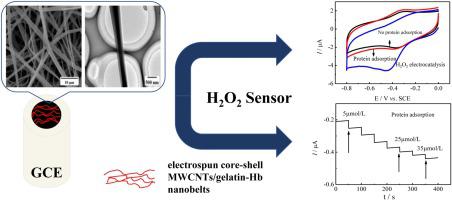当前位置:
X-MOL 学术
›
Process Biochem.
›
论文详情
Our official English website, www.x-mol.net, welcomes your
feedback! (Note: you will need to create a separate account there.)
Effect of protein adsorption on bioelectrochemistry of electrospun core-shell MWCNTs/gelatin-Hb nanobelts on electrode surface
Process Biochemistry ( IF 3.7 ) Pub Date : 2020-09-01 , DOI: 10.1016/j.procbio.2020.05.031 Z.X. Deng , J.W. Tao , L.J. Zhao , W. Zhang , Y.B. Wang , H.J. Mu , H.J. Wu , X.X. Xu , W. Zheng
Process Biochemistry ( IF 3.7 ) Pub Date : 2020-09-01 , DOI: 10.1016/j.procbio.2020.05.031 Z.X. Deng , J.W. Tao , L.J. Zhao , W. Zhang , Y.B. Wang , H.J. Mu , H.J. Wu , X.X. Xu , W. Zheng

|
Abstract Implantable electrochemical biosensor is one powerful tool for the accurate and reliable measurements of small molecules in vivo. However, the electrode is inevitably subjected to the protein adsorption when implanted into the living animals, affecting the sensitivity and stability of biosensor. Herein, we designed the multi-walled carbon nanotubes/gelatin-hemoglobin (MWCNTs/gelatin-Hb) core-shell nanobelts constructed on glassy carbon electrode (GC) using the one-step electrospinning technique for studying the effect of protein adsorption on the electrode surface properties. The results of the water contact angle and the scanning electron microscopy (SEM) showed that the electrospun core-shell MWCNTs/gelatin-Hb nanobelts present hydrophilic and certain anti-protein adsorption properties. Direct electron transfer between the Hb molecules in the electrospun core-shell nanobelts and electrode and catalysis of hydrogen peroxide (H2O2) can be still achieved after the electrospun core-shell MWCNTs/gelatin-Hb nanobelts adsorbed protein. Moreover, compared with before protein adsorption ( K m app =0.0155 mmol/L), the electrospun core-shell MWCNTs/gelatin-Hb nanobelts after protein adsorption still displayed high biological affinity to H2O2 ( K m app =0.0382 mmol/L). The constructed H2O2 biosensor by using the electrospun core-shell MWCNTs/gelatin-Hb nanobelts showed high sensitivity, great reproducibility and stability after protein adsorption. This study provides a novel design and an effective platform for the development of implantable electrochemical biosensors.
中文翻译:

蛋白质吸附对电极表面电纺核壳多壁碳纳米管/明胶-Hb纳米带生物电化学的影响
摘要 植入式电化学生物传感器是一种在体内准确可靠测量小分子的有力工具。然而,电极在植入活体动物体内时不可避免地会受到蛋白质的吸附,影响生物传感器的灵敏度和稳定性。在此,我们使用一步静电纺丝技术设计了构建在玻碳电极(GC)上的多壁碳纳米管/明胶-血红蛋白(MWCNTs/gelatin-Hb)核壳纳米带,用于研究蛋白质吸附对电极的影响表面特性。水接触角和扫描电子显微镜(SEM)结果表明,电纺核壳多壁碳纳米管/明胶-Hb纳米带具有亲水性和一定的抗蛋白质吸附性能。在电纺核壳MWCNTs/明胶-Hb纳米带吸附蛋白质后,电纺核壳纳米带中的Hb分子与电极之间的直接电子转移和过氧化氢(H2O2)的催化仍然可以实现。此外,与蛋白质吸附前(K m app =0.0155 mmol/L)相比,蛋白质吸附后的电纺核壳MWCNTs/明胶-Hb纳米带仍显示出对H2O2的高生物亲和力(K m app =0.0382 mmol/L)。使用电纺核壳多壁碳纳米管/明胶-Hb纳米带构建的H2O2生物传感器在蛋白质吸附后表现出高灵敏度、良好的重现性和稳定性。该研究为可植入电化学生物传感器的开发提供了一种新颖的设计和有效的平台。
更新日期:2020-09-01
中文翻译:

蛋白质吸附对电极表面电纺核壳多壁碳纳米管/明胶-Hb纳米带生物电化学的影响
摘要 植入式电化学生物传感器是一种在体内准确可靠测量小分子的有力工具。然而,电极在植入活体动物体内时不可避免地会受到蛋白质的吸附,影响生物传感器的灵敏度和稳定性。在此,我们使用一步静电纺丝技术设计了构建在玻碳电极(GC)上的多壁碳纳米管/明胶-血红蛋白(MWCNTs/gelatin-Hb)核壳纳米带,用于研究蛋白质吸附对电极的影响表面特性。水接触角和扫描电子显微镜(SEM)结果表明,电纺核壳多壁碳纳米管/明胶-Hb纳米带具有亲水性和一定的抗蛋白质吸附性能。在电纺核壳MWCNTs/明胶-Hb纳米带吸附蛋白质后,电纺核壳纳米带中的Hb分子与电极之间的直接电子转移和过氧化氢(H2O2)的催化仍然可以实现。此外,与蛋白质吸附前(K m app =0.0155 mmol/L)相比,蛋白质吸附后的电纺核壳MWCNTs/明胶-Hb纳米带仍显示出对H2O2的高生物亲和力(K m app =0.0382 mmol/L)。使用电纺核壳多壁碳纳米管/明胶-Hb纳米带构建的H2O2生物传感器在蛋白质吸附后表现出高灵敏度、良好的重现性和稳定性。该研究为可植入电化学生物传感器的开发提供了一种新颖的设计和有效的平台。











































 京公网安备 11010802027423号
京公网安备 11010802027423号